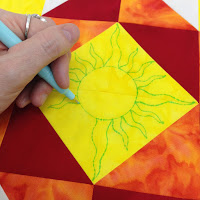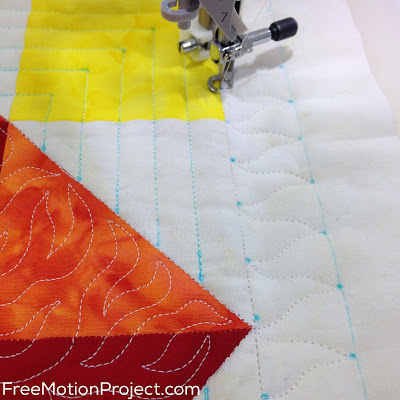How to Mark Your Quilting Design

On Monday we learned how to piece our first block, and now it’s time to think about the quilting. The first step to getting your block ready for quilting is to mark it with the quilting diagram.
Looking for the first quilting diagram? Find it in the Block #1 Quilt Pattern!
Why are we marking the design?
In machine quilting there are two ways to quilt: on a marked like or free hand (without marks). Free hand quilting requires a lot more practice and repetition. It’s a lot like learning how to write in cursive – you have to memorize the rules of the design, then fill in the area by following the memorized pattern.
Quilting on a marked line is much much easier because it doesn’t require the practice or memorization. You just quilt on the marked lines!
This machine quilting method is also easier because it will allow you to focus on moving the quilt and balancing that movement with the speed of your machine. This is how you create even, consistent stitches, and this is the challenging part of free motion quilting because balancing this speed / movement is different for everyone.
So having the marked lines will make your life much easier and make quilting the blocks faster. Learn how to mark the blocks with your quilting design in this video:
When you print the pattern, make sure to check the box for “actual size” in your printer dialog box so the pages print properly. You can check by measuring the 1 inch box on those pages. When taped together the diagram should measure 14 inches.
The marking pencil I’m mostly using is the Fine Line Water Soluble Pen. It produces a bright blue line that looks pretty ugly on my bright fabrics, but it’s definitely easy to follow! After quilting our block, we will rinse out these marks so we can see the quilting.
Ways to save marking time
No, I didn’t mark every single area of my block. I didn’t mark the darker area filled with Sharp Stippling because I’ve memorized this filler design and I know I can quilt it into this area without the marked lines.
I also skipped marking every single individual flame in the outer border. I marked dots instead to mark the points which was both faster and will result in a more unique design in that area.

So you’re welcome to skip marking areas if you don’t need them, but it’s a good thing to have if you’re just getting started.
Are you planning to mark all the lines in your block? Do you have a lightbox to mark or plan to use a bright window? Click Here to watch a video on marking a block using a window.
Now that our block is marked, the next step is basting! Come back tomorrow for tips on basting your block securely and the batting I’ve chosen for this project.
Let’s go quilt!
Leah Day

Thanks Leah! I also find a way that helps me is to draw out the quilt design a few times on paper to build that muscle memory and then it makes it flow easier once I go to the machine… marked or not..